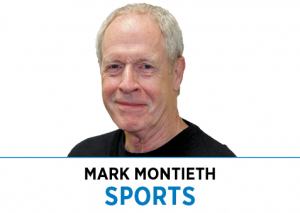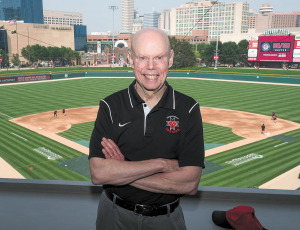Subscriber Benefit
As a subscriber you can listen to articles at work, in the car, or while you work out. Subscribe Now He made the decision to pursue it at 14, began preparing for it at 17, and got it at 21. Now 71, he’s not about to give it up.
He made the decision to pursue it at 14, began preparing for it at 17, and got it at 21. Now 71, he’s not about to give it up.
“It’s been a dream come true,” Howard Kellman says.
It would be easy to assume Kellman, voice of the Indianapolis Indians for all but two seasons since 1974, actually fell a step short of his dream, having never ascended to a full-time job with a Major League Baseball team. He tried a handful of times, came very close a few times, and was frustrated each time.
Sometimes, though, it takes awhile to realize you’re fortunate to be where you are. Maybe ending up in the same place you started isn’t a bad thing. Maybe the journey really is more important than the destination. Maybe having a stable job that you still enjoy is the best anyone can do.
“He’s such a fixture, and he cares about it so much,” says Kellman’s friend and mentor, Bob Costas. “My sense is that he’s never slacked off, that he feels the same responsibility to be prepared and do as well as he can as when he was in his 20s and 30s.”
Most play-play-play announcers began their professional careers in humbling fashion, in next-to-nowhere places for next-to-nothing paychecks. Don Fischer, headed for his 51st year broadcasting Indiana University football and basketball, started in Butte, Montana, with an annual salary of $4,000. Mark Boyle, the Pacers’ radio voice since 1987, started in Miles City, Montana, the following decade for $8,000 per year. Chris Denari, with help from his father’s connection, started in a relative metropolis, Columbus, Indiana, but endured two layoffs and had to veer in and out of the profession before the Pacers offered him their television position in 2006.
Kellman started from a higher vantage point—a Triple-A baseball franchise in Indianapolis. But he had paid his dues as well. His broadcast journey, built on initiative, hustle and postage stamps, can go toe-to-toe with nearly anyone’s. It stands as both an inspiration for and a warning to aspiring sportscasters who might wonder what it takes to become a fixture in a major market.It takes a lot.
Humble beginnings
Kellman began at 17 by announcing games into a reel-to-reel tape recorder while watching on television from his family’s home in the Sheepshead Bay neighborhood of Brooklyn. At 19, while a student at Brooklyn College, he talked his way into a gig announcing St. John’s basketball games. He also broadcast their football games for local television, although it was just a club sport. He even called in sports updates to a New York radio station for $10 a pop.
He was more enterprising than that, however. He took his tape recorder to Yankee Stadium, found an isolated seat in the upper deck, and called the game. As you might imagine, some fans overheard and approached him to ask what in the world he was doing, forcing him to interrupt and explain. He did the same for some Knicks games at Madison Square Garden. It was harder to get away from other fans there, but he did the best he could.
All the while, he was making contacts, meeting the local pros and seeking their advice. One of them was Marv Albert, not yet a nationally known figure but popular locally. Kellman kept stats for Albert a few times and copied some of the things Albert had done to get started.
“I remember talking to him on the phone a number of times,” Albert says. “He had great passion and knew baseball. He knew basketball, too.”
When George Steinbrenner bought the Yankees a couple of years later, in 1973, Kellman wrote the new owner a letter and asked if he could practice his play-by-play in a spare broadcast booth. The letter was passed on to an associate, who granted permission. Albert had done the same thing years earlier with the Brooklyn Dodgers at Ebbets Field before they moved to Los Angeles. From there, oh-so-close to the pros, Kellman was able to sit in a booth and broadcast an entire game into his recorder.
Getting his shot
Heading into his senior year of college—he was a speech major, an honor student who took his classes seriously—he set his sights on landing a job. He went to the Major League Baseball commissioner’s headquarters in Manhattan for two hours on a fall weekday afternoon, was loaned a manual with the address of every minor league team—about 110 in all—and directed to a spare room where he could copy them all down. Over the next month or so, he wrote a letter to every team, typing each one separately, and mailed it out. Stamps cost 8 cents at the time, so it was more an investment of time than money.
Twenty-five teams replied. (His naivety was such that he thought his letters to the teams that didn’t respond had been lost in the mail.) Of those 25, only three had job openings. One was Indianapolis. General Manager Max Schumacher wrote back to tell him they had an opening, but it would be a few months before a decision could be reached.
Kellman mailed a reel-to-reel tape of one inning of play by play he had recorded during a Yankees-Red Sox game the previous summer. He was one of about 100 applicants, however, and Schumacher needed time to wade through them all. He enlisted the help of Pat Sullivan, a local judge who was a member of the Indians’ board of directors, and they agreed Kellman’s deserved a follow-up.

Schumacher called Kellman in mid-February of 1974 to invite him to Indianapolis for an interview. “When can you come?” Kellman, nothing if not committed, said, “How about tomorrow?” Schumacher laughed and said he would fly him out the following week.
Kellman got the job. Salary: $4,000 annually. He survived on that by living in a furnished efficiency at the Indy Inn Hotel at 407 N. Pennsylvania St. It’s long gone, but even then, the city was attempting to shut it down because of fire code violations. It was good enough for Kellman, though. He paid just $8 per day, ate every meal out and rode a bus to the ballpark. He got a ride home afterward with ticket manager Harry James, who bought him a steak dinner—about $4—at the St. Moritz.
When the Indians went on the road, Kellman put his clothes in storage at the hotel and lived off the team’s per diem: $7.50.
“It was a lot of fun,” he recalls. “It was a kick to get meal money. I remember reading in [best-selling book] ‘Ball Four’ about meal money.”
His first game brought what still ranks as his most embarrassing moment. The Indians opened the season on April 17 in Evansville, where the visiting broadcast booth was positioned along the third base line. Evansville’s Danny Meyer hit what looked from Kellman’s vantage point to be a foul ball as it sailed out of his view. It turned out to be a three-run homer.
Kellman survived that mishap with nothing more than an offhand comment from Schumacher. Today, more than 6,700 games later, he has yet to be reprimanded by management for saying something inappropriate on the air. Or off, for that matter. He’s never missed a game because of illness, either, other than those missed in June 2016 after suffering a heart attack while preparing for a broadcast at Victory Field. He’s a fitness and nutrition fanatic, which has enabled him to overcome his family history of heart disease.
Still jumping
He’s covered a lot of great players in Triple-A baseball, both for and against the Indians, and had a lifetime of temporary broadcast opportunities as well. He’s had his “cups of coffee” in the majors, filling in on both Mets (2014) and Yankees (2022) broadcasts. He also worked three White Sox games in 1984. He announced 21 Cleveland NBA games during the 1988-1989 season. He broadcast the Triple-A World Series for ESPN from 2006-2008. He was a sideline reporter for Yale football in 2012. He’s filed reports for national radio networks from IU, Purdue and Pacers games.
Locally, he announced Noblesville High School football games for $30 each in 1977 for a daytime-only station that aired the broadcast the following day. He covered Racers hockey games as well. Once got Gordie Howe to record an interview to be run on his 50th birthday that he sold to a few networks. He’s also announced a high school football and basketball Game of the Week for WHMB-TV Channel 40 since 1990. He’s a motivational speaker as well, so he works virtually year-round, from various locales. He’s also got a side career as an ad salesman. He was forced into that role in 1977, when the Indians were going to lose their two radio affiliates, in Lebanon and Franklin, if he didn’t find enough sponsors to keep the games on the air. After some serious pavement-pounding, he did, and has continued to excel in that role ever since.
He hasn’t traveled with the Indians since COVID canceled the 2020 season, however. He and his broadcasting sidekick, either Jack McMullen or Andrew Kappas, call the road games from their Victory Field booth while watching the game on a television monitor. Sometimes, if the stadium isn’t being used for another event, they are the only ones there. Kellman has a key fob to let them in, and the light in their booth is the only sign of life.
It’s not an ideal broadcast position, but Kellman has no complaints. He became accustomed to humble surroundings a long time ago, sitting in the stands with a reel-to-reel recorder. “I tell [Indians management] I’m OK with whatever they want to do; I understand both sides,” he says.
Besides, in a sense, he’s come full circle: calling games off a monitor, just like he did at 17. Only now he gets paid for it.
“My sense is that he has the whole thing in perspective now,” says Costas, who met Kellman while broadcasting Triple-A games for the St. Louis Cardinals affiliate during the Major League strike in 1981.
“He’s had a full life in baseball. He’s probably seen more in baseball than most of us. There’s a million guys out there who, if you told them you’ll never have to work a real job and you’ll make a living at it, would jump at the chance.”
Kellman is still jumping. It’s all he knows.•
__________
Montieth, an Indianapolis native, is a longtime newspaper reporter and freelance writer. He is the author of three books: “Passion Play: Coach Gene Keady and the Purdue Boilermakers,” “Reborn: The Pacers and the Return of Pro Basketball to Indianapolis,” and “Extra Innings: My Life in Baseball,” with former Indianapolis Indians President Max Schumacher.
Please enable JavaScript to view this content.
